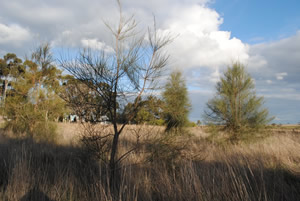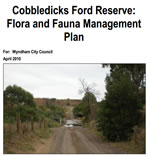John Todd’s memories unless stated otherwise.
 |
| Stand of bulokes (Allocasuarina leuhmannii) planted to commemorate John Todd, Crown Land Bailiff, 10th April 1953 – Feb.1995 |
Cobbledicks Ford as we see it today was built by four local day labourers which included Mr. Samuel Cobbledick for the Wyndham Road District, with bluestone pitchers in 1883. R.H.
The Cobbledicks came originally from the western area of Victoria, they were descendants of the early whalers. Mr Cobbledick was a tenant farmer leasing from the Staughton’s, the original owners of Eynesbury.
Cobbledick’s was a dairy farm. Mangel-wurzel (beet) was grown for cattle on the river flats. Cobbledicks bluestone house was built approx. in 1863, the date was inscribed on a stone over the door. A 1935 auction notice describes Cobbledicks dwelling as a ‘Blue Stone House, 4 rooms; large milking shed and necessary outbuildings’ on ‘rich river flats suitable for dairying and mixed farming.’
“In October 1862 the Township of Wyndham (surveyed in 1849) was proclaimed as the Wyndham Road District. And in December 1862 the Wyndham District Road Board was formed, and in 1864 the Shire of Wyndham was proclaimed.” (R. H.) “On the 19 May 1866, Cobbledicks house was used once as a North Riding polling place, for the first Wyndham Shire Council elections.” (R.H. and L.H.)
1866 The Post Office opened at Mt. Cotterell
The 61 acre (24.4ha) reserve, named after Samuel Cobbledick, was ‘permanently reserved from sale by being gazetted in 1873 as a ‘Site for Public Recreation and Watering purposes.’ (R.H.) The reserve used to be surrounded by post and rail fence and netting.
Picnics were held at the reserve ‘In 1878, 300 people attended to enjoy ham, pound cake, jam tarts and fruit and to dance until dark. The children ran races, the woman wore their finest dresses, and songs and speeches added to the entertainment.’ Bacchus Marsh Express 2 March.
The first recorded instance of foot and mouth disease in Australia was in 1872 at the Cobbledicks farm.
‘In February 1872 the ship the Northumberland reached Melbourne carrying stock including the bull ‘Achmet’. The animals were taken to the Royal Horse Bazaar in Bourke Street. 2 May, Achmet was sold at auction to William Staughton, of Staughton Brothers, a nose ring was fitted. Achmet was led along the Ballarat Road at Kororoit Creek (now Deer Park Hotel). 4 May Achmet walked further along Ballarat Road to the Exford Estate. 5 May Achmet walked to W. Staughton’s property on the south-west side of what then was Staughton’s Bridge. Later in the day Achmet crossed the river and passed through Clark’s farm, where Cobbledicks Recreation Reserve now stands, through Cobbledicks Ford to Cobbledicks farm. 8 or 9 May, Achmet dribbled saliva and dropped some food while eating, and his appetite was reduced. 9 or 10 May, white blisters were found on Achmet’s nose. 14 or 15 May, the first of Cobbledicks cows developed the disease.’ The cattle were diagnosed with foot and mouth disease and were later slaughtered and buried. Extracts from Foot and Mouth Disease in Australia with Particular Reference to the Victorian Incident of 1872. E.M. Pullar D.V.Sc. 1964-65
Mount Cotterell State School No.804 3rd location was operating part time in the earliest record 1864 & 1880’s and 90’s late 1890’s closed down. Re-erected in the 1900’s
‘The school closed in 1949’ Heritage of the City of Wyndham 1997, Context
There used to be a sign STOCK ROUTE where Dohertys Road crossed the sewer outfall at Laverton. Travelling stock were using the reserve until the 60’s. MP Davis had 2 -3,000 sheep on the roads.
The Johnsons who leased the land in the 1904-05, grandmother died of bubonic plague.
Eynesbury leased the reserve in the 1940’s (McPherson) and early 50’s (Baillieu) and grazed rams there.
Mrs. Ron Smith used to put her cows on the reserve in the 50’s, she died in 1957/58, and sold her land to Tom Galvin.
Money spent from the agistment fees was spent on erecting the windmill and water trough installed by the 1920’s and extending the school. After the 40’s the money from stock agistment went to the Werribee Council Reserves.
Ron Smith tells of burning coke in the old hollowed blue gum trunk.
Soil was periodically removed from near the road near the cutting to the ford
The sugar gums beside the entrance road were planted by Mr. Thomas Crinnigan in the 1920’s.
The first fire that JT remembers occurred in the early 50’s in the boxthorn bushs rabbits scattered everywhere. The fire was fought with knapsacks.
There were always boxthorns on the reserve, occasionally kangaroos.
The telephone pole was linked with the bombing range on Eynesbury, practising for WW 2 and the Korean war. The rocket range on Ballan road was used for the Vietnam war.
JT was appointed Crown Land Bailiff 10th April 1953 – February 1995. John lived at ‘Bambra Park’, the property adjacent to the reserve.
The vandals started in the 1960’s, this problem gradually worsened as cars became more prevalent. Post 1975 the landscaping, trails and tree planting took place. Flooding 1983
Compiled by Frances Overmars
R.H. Rosemary Harrigan (Werribee District Historical Society) L.H Lisa Heinrich

